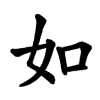Definify.com
Definition 2025
人
人
| ||||||
|---|---|---|---|---|---|---|
Translingual
| Stroke order | |||
|---|---|---|---|

| |||
Alternative forms
- 亻 (when used as a left radical)
Han character
人 (radical 9 人+0, 2 strokes, cangjie input 人 (O), four-corner 80000)
- Kangxi radical #9, ⼈ (“man”).
Usage notes
In print, 人 may have symmetric legs. However in handwriting, to distinguish from 入, the right leg will be shorter, the shape looking like a ʎ; in 入 the left leg is shorter.
Derived characters
- Index:Chinese radical/人
- 飤
References
- KangXi: page 91, character 1
- Dai Kanwa Jiten: character 344
- Dae Jaweon: page 190, character 1
- Hanyu Da Zidian: volume 1, page 101, character 10
- Unihan data for U+4EBA
Chinese
|
simp. and trad. |
人 | |
|---|---|---|
| alt. forms |
亻 component 𠆢 component 几 𠔽 𤯔 |
|
Glyph origin
| Historical forms of the character 人
| ||||||||||||||||||||||||||||||||||||||||||||||||||||||||||||||||||||||||||||||||||||||||||||||||||||||||||||||||||||||||||||||||||||||||||||||||||||||||||||||||||||||||||||||||||||||||||||||||||||||
|---|---|---|---|---|---|---|---|---|---|---|---|---|---|---|---|---|---|---|---|---|---|---|---|---|---|---|---|---|---|---|---|---|---|---|---|---|---|---|---|---|---|---|---|---|---|---|---|---|---|---|---|---|---|---|---|---|---|---|---|---|---|---|---|---|---|---|---|---|---|---|---|---|---|---|---|---|---|---|---|---|---|---|---|---|---|---|---|---|---|---|---|---|---|---|---|---|---|---|---|---|---|---|---|---|---|---|---|---|---|---|---|---|---|---|---|---|---|---|---|---|---|---|---|---|---|---|---|---|---|---|---|---|---|---|---|---|---|---|---|---|---|---|---|---|---|---|---|---|---|---|---|---|---|---|---|---|---|---|---|---|---|---|---|---|---|---|---|---|---|---|---|---|---|---|---|---|---|---|---|---|---|---|---|---|---|---|---|---|---|---|---|---|---|---|---|---|---|---|
| Oracle bone script | Bronze inscriptions | Bamboo and silk script | Large seal script | Small seal script | ||||||||||||||||||||||||||||||||||||||||||||||||||||||||||||||||||||||||||||||||||||||||||||||||||||||||||||||||||||||||||||||||||||||||||||||||||||||||||||||||||||||||||||||||||||||||||||||||||
 |
 |
 |
 |
 |
||||||||||||||||||||||||||||||||||||||||||||||||||||||||||||||||||||||||||||||||||||||||||||||||||||||||||||||||||||||||||||||||||||||||||||||||||||||||||||||||||||||||||||||||||||||||||||||||||
| ||||||||||||||||||||||||||||||||||||||||||||||||||||||||||||||||||||||||||||||||||||||||||||||||||||||||||||||||||||||||||||||||||||||||||||||||||||||||||||||||||||||||||||||||||||||||||||||||||||||
|
References:
Mostly from Richard Sears' Chinese Etymology site (authorisation),
| ||||||||||||||||||||||||||||||||||||||||||||||||||||||||||||||||||||||||||||||||||||||||||||||||||||||||||||||||||||||||||||||||||||||||||||||||||||||||||||||||||||||||||||||||||||||||||||||||||||||
| Characters in the same phonetic series (人) (Zhengzhang, 2003) | |
|---|---|
| Old Chinese | |
| 千 | *sn̥ʰiːn |
| 仟 | *sn̥ʰiːn |
| 芊 | *sn̥ʰiːn, *sn̥ʰiːns |
| 阡 | *sn̥ʰiːn |
| 汘 | *sn̥ʰiːn |
| 迁 | *sn̥ʰiːn |
| 杄 | *sn̥ʰiːn |
| 人 | *njin |
| 仁 | *njin |
| 朲 | *njin |
| 佞 | *neːŋs |
Pictogram (象形) – resembles the legs of a human being. The ancient version of this character depicted a man with arms and legs. Compare 大.
Etymology 1
Pronunciation
- Mandarin
- Cantonese (Jyutping): jan4, jan4-2, jan4-1
- Hakka (Sixian, PFS): ngìn
- Min Dong (BUC): ìng
- Min Nan
- Wu (Wiktionary): nyin (T3); zen (T3)
- Mandarin
- (Standard Chinese, Beijing)+
- Pinyin:
- Zhuyin: ㄖㄣˊ
- Wade-Giles: jên2
- Gwoyeu Romatzyh: ren
- IPA (key): /ʐən³⁵/
-

- (Standard Chinese, Beijing)+
- Cantonese
- (Standard Cantonese, Guangzhou)+
- Jyutping: jan4, jan4-2, jan4-1
- Yale: yàhn, yán, yān
- Cantonese Pinyin: jan4, jan4-2, jan4-1
- IPA (key): /jɐn²¹/, /jɐn²¹⁻³⁵/, /jɐn²¹⁻⁵⁵/
- (Standard Cantonese, Guangzhou)+
- Hakka
- (Sixian, incl. Miaoli and Meinong)
- Pha̍k-fa-sṳ: ngìn
- Hakka Romanization System: nginˇ
- Hagfa Pinyim: ngin2
- IPA: /ɲin¹¹/
- (Sixian, incl. Miaoli and Meinong)
- Min Dong
- (Fuzhou)
- Bàng-uâ-cê: ìng
- IPA (key): /iŋ⁵³/
- (Fuzhou)
- Min Nan
- (Hokkien: Zhangzhou, Kaohsiung)
- Pe̍h-ōe-jī: jîn
- Tâi-lô: jîn
- Phofsit Daibuun: jiin
- IPA (Zhangzhou): /d͡ʑin¹³/
- IPA (Kaohsiung): /d͡ʑin²³/
- (Hokkien: Xiamen, Quanzhou, Taipei)
- Pe̍h-ōe-jī: lîn
- Tâi-lô: lîn
- Phofsit Daibuun: liin
- IPA (Xiamen): /lin²⁴/
- IPA (Quanzhou): /lin²⁴/
- IPA (Taipei): /lin²⁴/
- (Teochew)
- Peng'im: ring5
- Pe̍h-ōe-jī-like: jîng
- IPA (key): /d͡ziŋ⁵⁵/
- (Hokkien: Zhangzhou, Kaohsiung)
- Wu
- (Shanghainese)
- Wiktionary: nyin (T3); zen (T3)
- IPA (key): /ȵɪɲ²³/, /z̻əɲ²³/
- Note: 3nyin - colloquial; 3zen - literary.
- (Shanghainese)
- Dialectal data▼
| Variety | Location | 人 |
|---|---|---|
| Mandarin | Beijing | /ʐən³⁵/ |
| Harbin |
/ʐən²⁴/ /in²⁴/ |
|
| Tianjin |
/in⁴⁵/ /ʐən⁴⁵/ |
|
| Jinan | /ʐẽ⁴²/ | |
| Qingdao | /iə̃⁴²/ | |
| Zhengzhou | /ʐən⁴²/ | |
| Xi'an | /ʐẽ²⁴/ | |
| Xining | /ʐə̃²¹³/ | |
| Yinchuan | /ʐəŋ⁵³/ | |
| Lanzhou | /ʐə̃n⁵³/ | |
| Ürümqi | /ʐɤŋ⁵¹/ | |
| Wuhan | /nən²¹³/ | |
| Chengdu | /zən³¹/ | |
| Guiyang | /zen²¹/ | |
| Kunming | /ʐə̃³¹/ | |
| Nanjing | /ʐən²⁴/ | |
| Hefei | /ʐən⁵⁵/ | |
| Jin | Taiyuan | /zəŋ¹¹/ |
| Pingyao | /ʐəŋ¹³/ | |
| Hohhot | /ʐə̃ŋ³¹/ | |
| Wu | Shanghai |
/ȵiŋ²³/ /zəŋ²³/ |
| Suzhou |
/zən¹³/ /ȵin¹³/ |
|
| Hangzhou | /zen²¹³/ | |
| Wenzhou |
/zaŋ³¹/ 文讀 /ȵaŋ³¹/ 白讀 /naŋ³¹/ 訓讀 |
|
| Hui | Shexian |
/iʌ̃⁴⁴/ /niʌ̃⁴⁴/ |
| Tunxi | /ian⁴⁴/ | |
| Xiang | Changsha | /ʐən¹³/ |
| Xiangtan | /in¹²/ | |
| Gan | Nanchang |
/ȵin⁴⁵/ /lɨn⁴⁵/ ~參 |
| Hakka | Meixian | /ŋin¹¹/ |
| Taoyuan | /ŋin¹¹/ | |
| Cantonese | Guangzhou | /jɐn²¹/ |
| Nanning | /jɐn²¹/ | |
| Hong Kong | /jɐn²¹/ | |
| Min | Xiamen (Min Nan) | /lin³⁵/ |
| Fuzhou (Min Dong) | /iŋ⁵³/ | |
| Jian'ou (Min Bei) | /neiŋ³³/ | |
| Shantou (Min Nan) |
/ziŋ⁵⁵/ /naŋ⁵⁵/ 訓讀 |
|
| Haikou (Min Nan) |
/zin³¹/ /naŋ³¹/ 訓儂 |
| Rime | |
|---|---|
| Character | 人 |
| Reading # | 1/1 |
| Initial (聲) | 日 (38) |
| Final (韻) | 眞 (43) |
| Tone (調) | Level (Ø) |
| Openness (開合) | Open |
| Division (等) | III |
| Fanqie | 如鄰切 |
| Reconstructions | |
| Zhengzhang Shangfang |
/ȵiɪn/ |
| Pan Wuyun |
/ȵin/ |
| Shao Rongfen |
/ȵʑjen/ |
| Edwin Pulleyblank |
/ȵin/ |
| Li Rong |
/ȵiĕn/ |
| Wang Li |
/ȵʑĭĕn/ |
| Bernard Karlgren |
/ȵʑi̯ĕn/ |
| Expected Mandarin Reflex |
rén |
| Baxter-Sagart system 1.1 (2014) | |
|---|---|
| Character | 人 |
| Reading # | 1/1 |
| Modern Beijing (Pinyin) |
rén |
| Middle Chinese |
‹ nyin › |
| Old Chinese |
/*ni[ŋ]/ |
| English | (other) person |
Notes for Old Chinese notations in the Baxter-Sagart system: * Parentheses "()" indicate uncertain presence; | |
| Zhengzhang system (2003) | |
|---|---|
| Character | 人 |
| Reading # | 1/1 |
| No. | 10800 |
| Phonetic component |
人 |
| Rime group |
眞 |
| Rime subdivision |
1 |
| Corresponding MC rime |
仁 |
| Old Chinese |
/*njin/ |
Definitions
人
- man, person, people (Classifier: 個/个)
- human being, Homo sapiens
- body
- everybody, everyone
- 人人 ― rénrén ― everybody
- 人手一冊 / 人手一册 ― rénshǒu yīcè ― It's a bestseller. (lit. Everyone has a copy.)
- physical, psychological or moral quality or condition
- a person associated with a particular identity or trait; -er
- manpower, worker, employee
- †talent, a person of talent
- †other people
- 人云亦云 ― rényún yìyún ― to follow the crowd (lit. to say what others say)
- †common people, commoner
- †adult, grown-up
- 長大成人 / 长大成人 ― chángdà chéngrén ― to grow up to be an adult
- †reason
- †sexual intercourse
- †company, companion, friend
- †Alternative form of 仁 (rén, “kernel”).
- †Alternative form of 仁 (rén, “charity”).
- †artificial, man-made
- 人禍 / 人祸 ― rénhuò ― human disaster
- †mortal
- †Alternative form of 仁 (rén, “loving, kind”).
Descendants
Etymology 2
|
simp. and trad. |
人 | |
|---|---|---|
| alt. forms |
儂/侬 𠆧 |
|
The Min native word for "person"; used as a replacement character for 儂/侬. Use of 人 is recommended by Taiwan's Ministry of Education.
Pronunciation 1
- Min Dong
- (Fuzhou)
- Bàng-uâ-cê: nè̤ng
- IPA (key): /nˡøyŋ⁵³/
- (Fuzhou)
- Min Nan
- (Hokkien)
- Pe̍h-ōe-jī: lâng
- Tâi-lô: lâng
- Phofsit Daibuun: laang
- IPA (Xiamen): /laŋ²⁴/
- IPA (Quanzhou): /laŋ²⁴/
- IPA (Zhangzhou): /laŋ¹³/
- IPA (Taipei): /laŋ²⁴/
- IPA (Kaohsiung): /laŋ²³/
-

- (Teochew)
- Peng'im: nang5
- Pe̍h-ōe-jī-like: nâng
- IPA (key): /naŋ⁵⁵/
- (Hokkien)
Definitions
人 (Min)
- man; person; people; human being; Homo sapiens
- a person associated with a particular identity or trait; -er
- 臺灣人 / 台湾人 [Min Nan] ― Tâi-oân-lâng [Pe̍h-ōe-jī] ― Taiwanese
- physical, psychological or moral quality or condition
- 伊人袂䆀。 [Min Nan] ― I lâng bē-bái. [Pe̍h-ōe-jī] ― He is kind (lit. His personality is not bad).
Pronunciation 2
- Min Dong
- (Fuzhou)
- Bàng-uâ-cê: nè̤ng
- IPA (key): /nˡøyŋ⁵³/
- (Fuzhou)
- Min Nan
- (Hokkien: Xiamen, Zhangzhou)
- Pe̍h-ōe-jī: lāng
- Tâi-lô: lāng
- Phofsit Daibuun: lang
- IPA (Xiamen): /laŋ²²/
- IPA (Zhangzhou): /laŋ²²/
- (Hokkien: Quanzhou)
- Pe̍h-ōe-jī: lǎng
- Tâi-lô: lǎng
- IPA (Quanzhou): /laŋ²²/
- (Hokkien: mainstream Taiwanese)
- Pe̍h-ōe-jī: lâng
- Tâi-lô: lâng
- Phofsit Daibuun: laang
- IPA (Taipei): /laŋ²⁴/
- IPA (Kaohsiung): /laŋ²³/
- (Teochew)
- Peng'im: nang7
- Pe̍h-ōe-jī-like: nāng
- IPA (key): /naŋ¹¹/
- (Hokkien: Xiamen, Zhangzhou)
Definitions
人 (Min)
Compounds
- ⇒ Appendix:Chinese compounds/人
Japanese
Kanji
Readings
- Goon: にん (nin)
- Kan’on: じん (jin)
- Kun: ひと (hito), り (ri)
- Nanori: じ (ji), と (to), ね (ne), ひこ (hiko), ふみ (fumi)
Compounds
|
|
|
|
Etymology 1
| Kanji in this term |
|---|
| 人 |
|
ひと Grade: 1 |
| kun'yomi |
/pi1to2/ → */pitə/ → /fito/ → /hito/
From Old Japanese.
Pronunciation
- Kun'yomi
-
(Tokyo) ひと [h
ìtó] (Heiban - [0])[1][2][3] -
(Tokyo) ひと [h
ìtóꜜ] (Odaka - [0])[2][3] - IPA(key): [çi̥to̞]
Noun
人 (counter 人, hiragana ひと, katakana ヒト, romaji hito)
Derived terms
|
Synonyms
- 方 (kata) (honorific)
Etymology 2
| Kanji in this term |
|---|
| 人 |
|
にん Grade: 1 |
| on'yomi |
From Middle Chinese 人 (nyin, “person”). The goon, so likely the earlier borrowing.
Pronunciation
Counter
Usage notes
The nin reading is used when counting three people or more. When counting one or two people as in 一人 (hitori, “one person”) or 二人 (futari, “two people”), the reading is り (-ri).
Etymology 3
| Kanji in this term |
|---|
| 人 |
|
じん Grade: 1 |
| on'yomi |
From Middle Chinese 人 (nyin, “person”). The kan'on, so likely a later borrowing.
Pronunciation
Suffix
- person from that group
- アジア人、イギリス人、スペイン人、ドイツ人、アメリカ人、スコットランド人
- Ajiajin, Igirisujin, Supeinjin, Doitsujin, Amerikajin, Sukottorandojin
- an Asian, an Englishman, a Spaniard, a German, an American, a Scot
- アジア人、イギリス人、スペイン人、ドイツ人、アメリカ人、スコットランド人
- person who does the activity of the suffixed word
References
- ↑ 2006, 大辞林 (Daijirin), Third Edition (in Japanese), Tōkyō: Sanseidō, ISBN 4-385-13905-9
- 1 2 1998, NHK日本語発音アクセント辞典 (NHK Japanese Pronunciation Accent Dictionary) (in Japanese), Tōkyō: NHK, ISBN 978-4-14-011112-3
- 1 2 1997, 新明解国語辞典 (Shin Meikai Kokugo Jiten), Fifth Edition (in Japanese), Tōkyō: Sanseidō, ISBN 4-385-13143-0
Korean
Hanja
人 • (in)
Eumhun:
- Sound (hangeul): 인 (revised: in, McCune-Reischauer: in, Yale: in)
- Name (hangeul): 사람 (revised: saram, McCune-Reischauer: saram, Yale: salam)
- This term needs a translation to English. Please help out and add a translation, then remove the text
{{rfdef}}.

































































































































































































